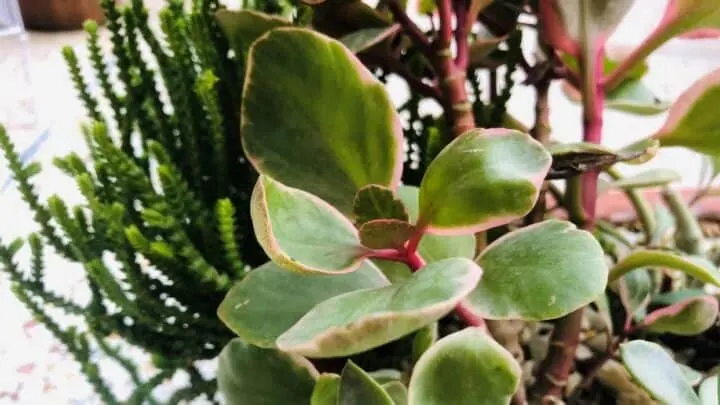With its vibrant pink, shiny white, and deep green colors, the Kalanchoe blossfeldiana, more specifically its variegated tricolor variety, is one of the most colorful succulent plants you could add to your space.
Native to the island of Madagascar, this bright-flowering species is known by many names, resulting in a lot of confusion.
The fact is Kalanchoe blossfeldiana has several different-looking varieties that go by different common names.
Flaming Katy, Florist Kalanchoe, and Madagascar Widow’s-thrill are some of the names that this plant is known by.
However, Flaming Katy is the most common English name.
Although the care guide is the same for all varieties of this species, we will be talking about the Variegated Tricolor variety in this article.
Table of Contents
Flaming Katy Care
Flaming Katy likes well-draining soil and mild sunlight for at least 6 hours a day. They should only be watered once the soil is fully dry. Ideal growing temperatures are between 65-80°F (18-26°C). The plant can be grown outdoors in USDA Hardiness Zones 7-11. Adequate ventilation is a must.
Soil
The Kalanchoe blossfeldiana plant likes a well-draining and well-aerated potting mix. This plant will do well in general-purpose succulent and cacti potting mix along with some organic compost. You can also use regular potting soil by adding sand and grit to it.
Your Flaming Katy plant will bring out its most vibrant colors if it’s provided the right soil to grow in. There is a general rule for potting soil you can follow with all succulents.
As long as the soil is well-draining and has got a gritty texture to it, your succulents are destined to grow well.
If you can’t get your hands on a cactus or succulent potting mix, no need to worry. With this easy potting mix recipe, you can make an even better mix for your plants, also at a lower cost. These are the ingredients for the DIY succulents potting mix.
- 2 parts sand
- 2 parts regular potting soil
- 1 part perlite
- 1 part organic compost
The organic compost is not absolutely necessary, but abundant nutrients available in the soil will translate into the liveliest colors on a Flaming Katy plant.
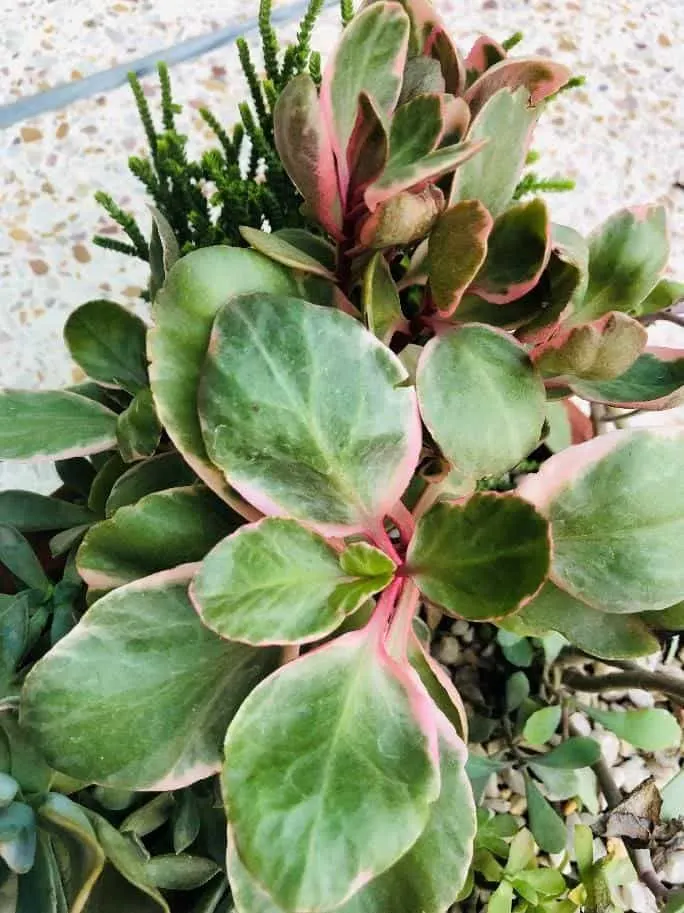
Light
Kalanchoe blossfeldiana needs ample sunlight to grow well. It likes to grow in mild sunlight for at least 6 hours a day and will only bloom if provided with it. If growing indoors, place it in a South facing window in the winter and an East or West facing window in the summer.
Light is one of the most important factors you need to get right to bring the best out of your Flaming Katy succulents. The Variegated Tricolor is a rare-blooming Kalanchoe, and they need consistent bright light every day to bloom.
Note that too much direct sunlight can cause the leaves to burn from the edges and will prevent the plant from blooming. In the summer, protect your Flaming Katy from harsh sun rays by placing it in bright indirect light.
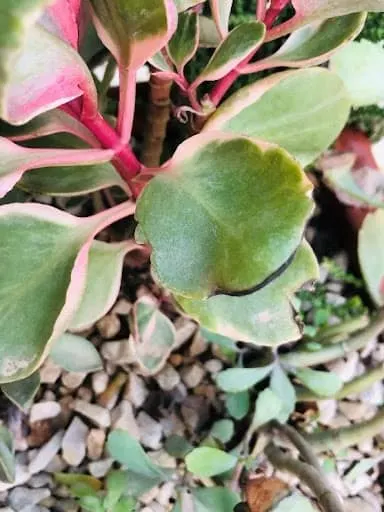
The plant’s appearance will deteriorate over time if it doesn’t receive the light it needs. The growth gets long and leggy as the succulent tries to reach for the light.
Watering
Flaming Katy succulents need water sparingly. They should only be watered once the soil is fully dry. Water well until the water flows out from the bottom of the pot. Water once or twice a week in summers and once every two weeks in winter.
You will have to observe a consistent watering practice if you want your Flaming Katy to bloom more often and for longer.
Most Flaming Katy owners tend to get everything but miss out on watering discipline, preventing their Flaming Katy plants from flowering and, in some cases, dying altogether.
These succulent plants will not mind it much if you miss a couple of watering sessions. But they are really sensitive to being overwatered.
Make sure the soil is completely dry by observing the color of the soil or sticking your finger to feel the soil moisture before you water.
Temperature
Keep your Flaming Katy plants safe from the cold. These tropical plants will not grow in temperatures below 50°F(10°C). Ideal growing temperatures are between 65-80°F (18-26°C). The plant can be grown outdoors from USDA Hardiness Zones 7-11.
The summer is the perfect time for Kalanchoe blossfeldiana to grow.
The sunlight and temperatures are just what it needs to thrive. In the winter, you must take special care of this plant.
Bringing it indoors is just not enough.
Don’t keep it in a drafty space or too near a glass window which can get awfully cold during the cold nights. Maintain a safe distance from cold objects and keep your plant warm at all times.
Humidity
Kalanchoe blossfeldiana thrives regardless of what the humidity levels are like, so you don’t have to make any special arrangements to cater to its humidity requirements. However, this plant does need adequate air ventilation to avoid catching fungal diseases.
Well-adapted top arid and semi-arid growing conditions, Flaming Katy doesn’t need the humidity to be above a specific level to grow well. It can flourish equally well even if humidity levels are below 10-20%.
If the humidity is too high, for instance, in the rainy season, and the plant does not get good air ventilation, mold infections such as Botrytis or Basal Stem Rot may be contracted.
Fertilizer
Kalanchoe species are not heavy feeders. Flaming Katy plants will do well even without fertilizer if potted in a soil mix with organic components. Still, a mild liquid fertilizer can be used twice every growing season to improve foliage, growth, and blooming.
Fertilizers rich in nitrogen content can be used to boost foliage growth. However, if you want more vivid and longer-lasting blooms, feeding your Flaming Katy with high-Phosphorous fertilizer will do the job.
You must note that these plants are not very fertilizer hungry. Like over-eating in humans, Flaming Katy plants can also suffer from nutrient toxicity if over-fertilized.
Growth
Kalanchoe blossfeldiana is a slow-growing species, with plants reaching maturity at the age of 3-5 years. When mature, these plants grow up to 2 feet in height as well as width. Blooms start appearing as soon as temperatures warm up in spring.
Flaming Katy plant’s foliage can be described as textured and glossy, with the tricolor variety boasting variegated leaves with deep pink leaf edges and petioles.
The soft stems are pink in color and turn brown and woody towards the base of the plant.
Growth stops in winter and picks up pace in the spring and summers. The plant will also grow suckers from beneath the soil that slowly develop into separate plants if not removed.
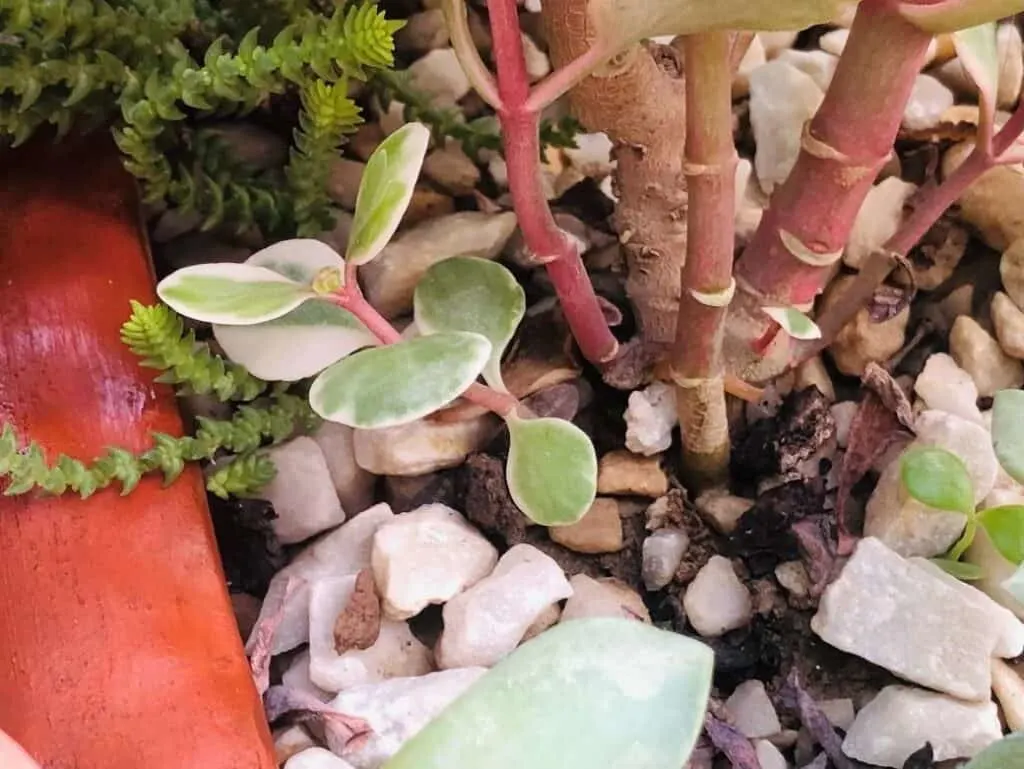
Potting
Clay pots are recommended to use for planting Flaming Katy plants. The pots must have drainage holes at the bottom. To improve drainage even more, line the lower part of the pot with pebbles or broken pieces of clay pots.
Kalanchoe blossfeldiana plants are not huge growers. Choosing a small-medium-sized pot is more than enough for this plant.
If you live in a hotter climate, moisture will evaporate from small pots very quickly, so a medium pot will do well.
Terra cotta pots are recommended for this plant. The porous quality of the clay allows aeration of the soil and keeps the plant protected from Root Rot.
Sometimes, soil tends to get compacted and blocks the drainage hole of a pot. This leads to poor drainage and eventually Root Rot.
Adding a layer of pebbles or broken pot pieces, specifically a large piece to cover the drainage hole, has many benefits. Not only does it keep the potting procedure tidy by preventing soil from falling out of the drainage hole, but it also ensures the pot’s drainage always remains unclogged.
Pruning
Pruning your Flaming Katy plant is good practice to keep blooms vigorous and maintain the overall look of the plant. Use a clean and sharp pruner to remove unsightly stems and to prune off fading blossoms.
Pruning does little good to succulents, but it is not the case with the Flaming Katy. This succulent responds really well to pruning. You can improve many aspects of this colorful by pruning it at the right time.
For instance, pinching off the tops of each stem before the blooming season will stimulate the flower buds and result in better blooms.
Dead plant matter must also be removed to reduce the risks of fungal infections.
Flaming Katy Propagation
This succulent can be propagated during the spring and summer from cuttings. Obtain a 2-3 inches long stem by making a slanting cut. Place the cuttings in a moist, well-draining succulent mix. The cutting will root in a few weeks.
It is fairly easy to propagate this plant if you’re propagating at the right time of the year. Growth usually stops in autumn and winter, so cutting away on lovely tricolor foliage will be vain.
If you’re in the spring or summer months, you can take a stem cutting by making a slanting cut using a sharp and sterilized pruner. This will allow the removed stem to absorb maximum moisture from the soil and root quicker.
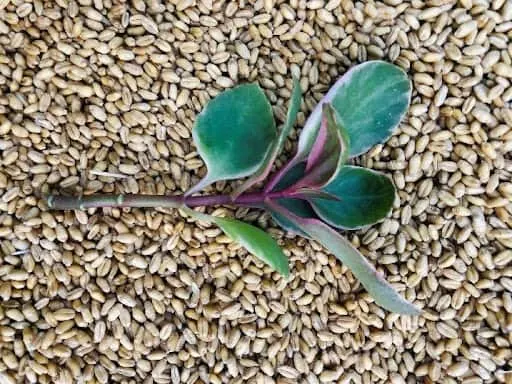
Place the cuttings in a moist succulent mix or any other sandy mix. Place the cuttings somewhere warm and bright but out of direct sunlight at all times. The cuttings shouldn’t take more than few weeks to root.
This plant can also be propagated by removing baby plants from neat the mother plant. Kalanchoe blossfeldiana typically grows suckers which develop a root system of their own soon after sprouting.
The suckers can be removed and turned into new plants. However, this procedure is more complicated and may require you to remove the whole plant from the soil.
Common Problems with Flaming Katy
Root Rot
The importance of avoiding over-watering your plant can never be stressed enough. The most common problem that leads to Flaming Katy plants suffering and eventually dying is the fungal root infection resulting from soggy soil.
Some of the signs of root rot in Flaming Katy are pale yellow foliage and the base of the plant turning black. You can treat Root Rot. However, most plants are far beyond the point of recovery when owners diagnose the problem, especially succulents.
Powdery Mildew
This is yet another fungal disease that your Flaming Katy can catch, probably because of high humidity and poor air ventilation. Powdery Mildew emerges as white, fluffy patches on the foliage of Kalanchoe blossfeldiana.
This plant likes drier conditions and will inevitably contract fungal-related diseases if kept in high humidity. To avoid this, place your plant away from other vegetation and ensure your plants get adequate ventilation.
You can easily get rid of Powdery Mildew by a few sprays of diluted neem oil.
Frequently asked questions about Flaming Katy Care
How to boost pink color in variegated Flaming Katy?
The pink color in plants is usually boosted by alkaline soil. Trying to artificially increase the pH level of the soil to make your Flaming Katy look pinker may result in plant fatality. You can still use garden lime or dolomite lime in suitable amounts in your potting mix to boost pink colors.
Why is my Kalanchoe blossfeldiana not blooming?
Kalanchoe blossfeldiana plants usually require a rest period to accumulate the energy it needs to bloom. The dormant period of autumn and winter serves as the hibernation period. If these plants are not allowed to rest and kept in the same summer-like conditions even in the winter, the plant will soon stop blooming.
How to improve ventilation for my Flaming Katy plant?
Place the plant near a window that gets regular wind flow. The plants should get an open space to live rather than be congested together with other plants. A fan is handy to blow fresh air to plants in hot and humid weather.
Conclusion
Regardless of the variety of Kalanchoe blossfeldiana you have with you, you can follow the same care guide as the variegated tricolor. Because, after all, they are all the same species.
Flaming Katy is one of the most colorful and rewarding succulents you could grow indoors. When it blossoms, it will undoubtedly steal the attention of every person in the room.

Daniel has been a plant enthusiast for over 20 years. He owns hundreds of houseplants and prepares for the chili growing seasons yearly with great anticipation. His favorite plants are plant species in the Araceae family, such as Monstera, Philodendron, and Anthurium. He also loves gardening and is growing hot peppers, tomatoes, and many more vegetables.

